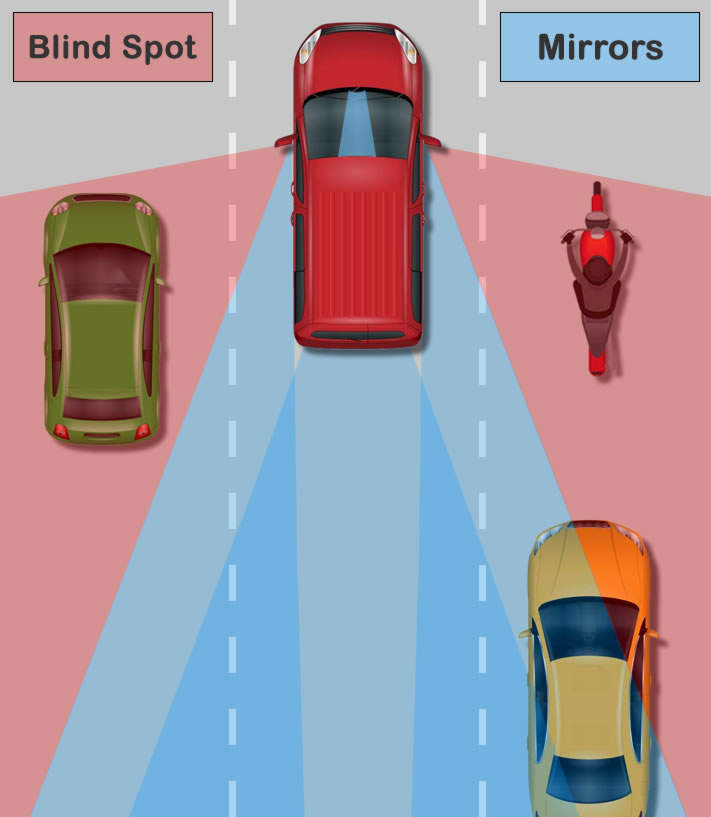In this tutorial we’re going to explain a very important observational safety check that all learner drivers must undertake and continue to carry out throughout their driving lifetime. That is blind spots and we’ll start with explaining exactly what a blind spot it.
What is a Blind Spot in a Car?
A blind spot is an area around the vehicle that the driver cannot observe while looking:
- forward out of the windscreen
- into the interior rear view mirror
- into either of the exterior side mirrors
Where Are the Blind Spots in a Car?
Blind spots on a car are located on each side of the vehicle. The internal rear view mirror offers an excellent view of the road behind your car and the external side mirrors provide rear and some observation to the side, but there are certain areas that are obscured from your mirrors and these are the blind spots.

This diagram illustrates red and blue shaded areas. Blue indicates the areas that the driver can see in all three mirrors and the red areas indicate areas that cannot be seen in the driver’s mirrors. The red shaded areas are blind spots.
Blind spots vary in size depending on the type of vehicle and the size and type of mirrors used, but in general, most vehicles have them. As can be seen, a cyclist, motorcyclist and even an entire car can be concealed in the blind spots. This is why it’s always important to check your blind spots.
How Do You check Blind Spots
Checking a blind spot is a procedure that simply requires the driver to look over their shoulder, to the left or right depending on which direction that are going. To check the blind spot:
- Look in the appropriate mirrors based on the direction you intend on taking
- Look over your shoulder to ensure the blind spot is clear of vehicles
- Indicate
- Carry out the manoeuvre
While checking the blind spot is a simple procedure, the difficult part is often remembering to always do it.
Why Do You Need to Check Blind Spots?
You need to check your car’s blind spots to avoid having a potential accident. Many accidents occur each year because a driver changes direction and forgets to check the blind spot beforehand.
When Should You Check the Blind Spots?
These are the most common situations where a driver must check the car’s blind spot:
- Before moving off from a parked position
- Before changing lanes
- Before turning onto a new road if you’ve just passed a cyclist
How do you prevent blind spots?
Some driving instructors claim to set their car’s mirrors in such a way that it covers all blind spots. While this may be true to some extent, the danger here is that it may get a driver out of the habit of checking. They then may find themselves in a situation (for example) where the mirrors may have been altered by another driver, or they may drive another car with a different mirror setup and forget to check the blind spots.
You can adjust your side view mirrors to minimise the blind spot (see adjusting your car mirrors) and you can also purchase additional ‘blind spot’ mirrors that fix to your existing side mirrors that help to reduce or even eliminate blind spots. Some modern vehicles also come equipped with blind spot detection systems. They alert the driver if the system determines that the driver is making an unintended lane change, or attempts to change lanes if a vehicle is already occupying that lane.
Whichever additional technique, aids or technology you use, the safest and best action to take is to always physically turn your head and visually check that a blind spot area is clear before moving into that space.
Blind Spots and the Driving Test
There are certain faults during a driving test that examiners mark as either a serious or dangerous fault, either of which is an instant test failure. One of these faults is a failure to check blind spots. Many tests are failed each year simply due to a learner driver forgetting to check a blind spot before carrying out a manoeuvre.